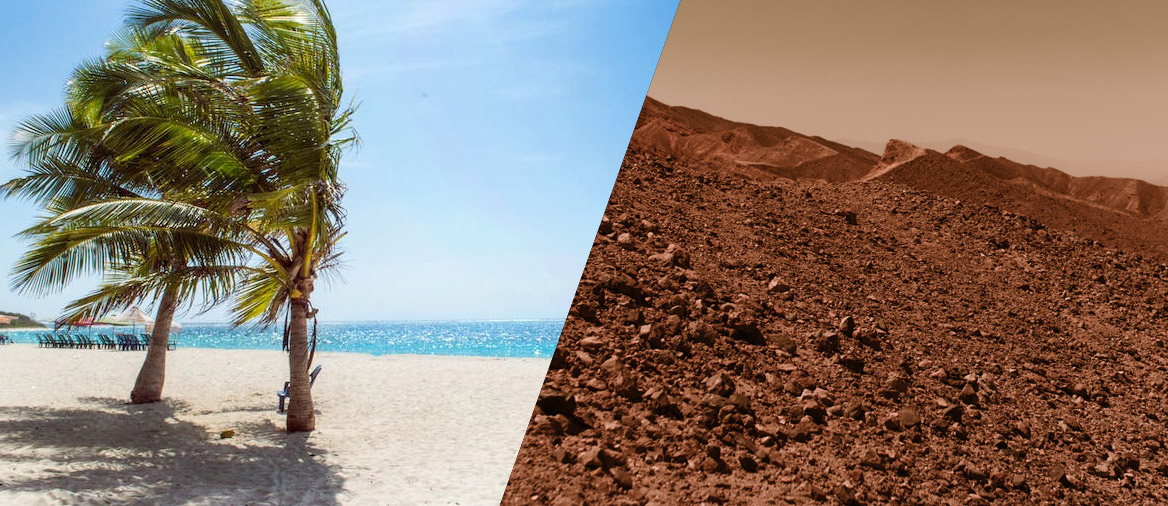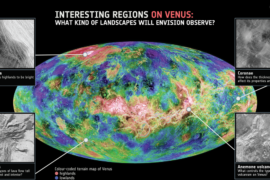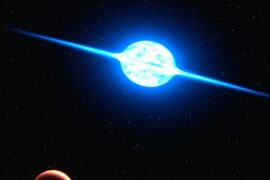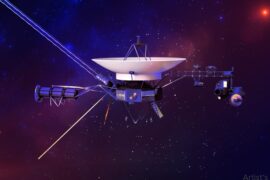It is very likely that Mars looked similar to Earth millions of years ago. What is now a red, cold, inhabitable planet might have been blue and warmer.
Mars is the planet scientists are the most interested in researching not just because it is close. It is because it shares many similarities with our own planet.
And yet, there are enough differences that make Mars the inhabitable environment it is today.
In this article, we’ll compare Earth and Mars and take a look at their differences and similarities which help us get a better understanding of our own past and why we might want to look into colonizing the planet.
Earth vs Mars comparison
| Earth | Mars | |
|---|---|---|
| Position in the Solar system | 3 | 4 |
| Distance from the Sun (avg) | 150 million km | 226 million km |
| Radius | 6,371 km | 3,389 km |
| Mass | 5.97237×1024 kg | 6.4171×1023 kg |
| Rotation period (1 day) | 24 h | 24 hours 37 minutes (1.025 days) |
| Rotation speed | 0.46 km/s | 0.24 km/s |
| Orbit period (1 year) | 365 days | 687 days |
| Orbital speed | 29.78 km/s | 24.07 km/s |
| Average temperature (outer) | 14 °C | −62°C |
| Surface pressure | 101.325 kPa | 0.636 kPa |
| Surface gravity | 9.8 m/s2 | 3.72 m/s2 |
| Density | 5.52 g/cm3 | 3.93 g/cm3 |
| Escape Velocity | 11.18 km/s | 5.027 km/s |
| Albedo | 0.367 | 0.170 |
| Satellites (Moons) | 1 | 2 |
| Core | rock | rock |
| Atmosphere | 78% N, 21% O | 95% CO2, 2.6% N2, 1.9% Ar, 0.16% O2, 0.06% CO |
Earth vs Mars size comparison
A common misconception is that Mars is big, when in fact, it is the second smallest planet in the Solar system.
If you compare its diameter with Earth’s, Mars is almost half the size of our planet.
When you compare both planets by volume, it turns out you could fit 6.5 Mars-sized planets on Earth.
Mars’ small size could be the reason why its moons, Phobos and Deimos, are also quite small compared to our Moon.
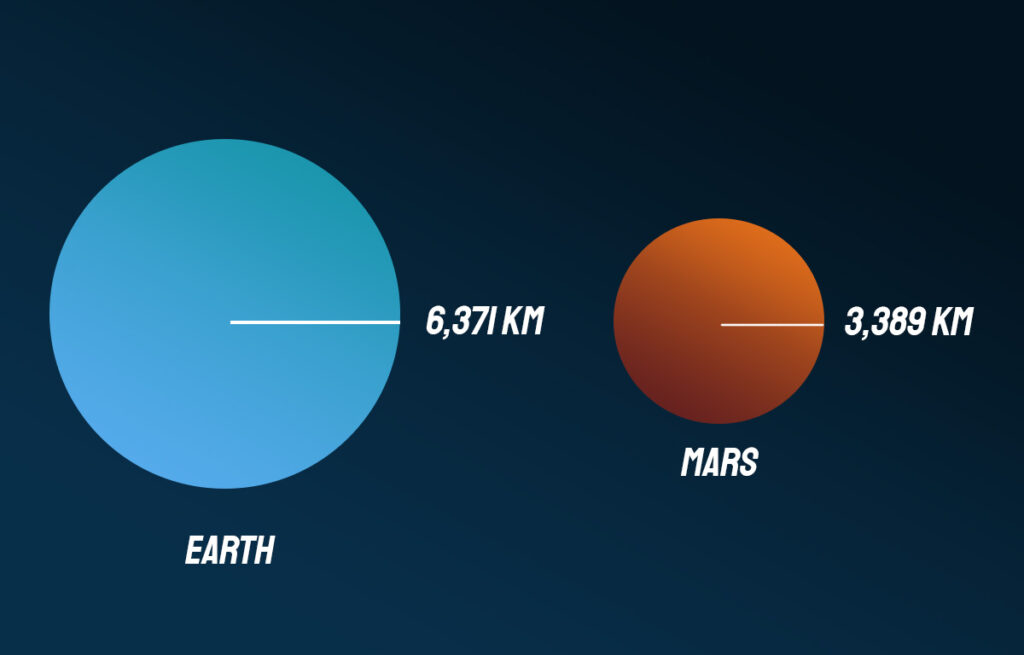
Earth and Mars similarities
- Both planets formed approximately at the same time, 4.5 billion years ago.
- Both planets orbit around the Sun.
- Earth and Mars have a rocky surface. Only the inner planets in the Solar system have solid surfaces (Mercury, Venus, Earth, and Mars).
- Both planets have polar caps covered in ice. Some scientists even believe that under Mars’ north pole, there could be pockets of temperatures that could be warm enough for liquid water to exist.
- Both planets have seasonal changes. Just like Earth has four seasons throughout the year, Mars has its own.
- The cores of both planets have a very similar composition, with high percentages of iron and nickel.
- Both planets have atmospheres.
- The rotation period of Earth and Mars is almost the same. The days of both planets are almost exactly 24 hours long. There are no other two planets in the Solar system that have such similar days.
- They both have magnetic fields.
- Both planets have valleys and mountains.
- Both planets have wind.
- Both planets have volcanoes although the ones on Mars are no longer active. Scientists believe that Mars was very geologically active in the past.
- Both planets have natural satellites. Earth has the Moon and Mars has two, named Phobos and Deimos.
- Both planets have clouds but Mars’ are few and thin.
- Both planets have winds. As a matter of fact, sandstorms are one of the main challenges the Mars rovers have when exploring the red planet.
- Earth and Mars both experience earthquakes.
- The axial tilt of the two planets is very similar. This means the seasons are very similar.
Earth and Mars differences
- Despite having days that are almost the same in length, Earth has to rotate almost twice as fast as Mars to achieve this because of its larger size.
- Earth has a magnetosphere, Mars doesn’t. It is very likely that Mars had one at some point but lost it because of an impact or because the planet cooled off.
- Even though Mars has an atmosphere, it is very weak compared to Earth’s.
- The composition of the atmospheres of Mars and Earth is very different. Earth’s atmosphere is mostly made out of nitrogen and oxygen. Mars’ is mostly carbon dioxide which would be toxic to humans.
- The gravity on Mars is much weaker. A 70 kg (154 lbs) person would weigh only 26.5 kg (58.5 lbs) on Mars.
- Earth has continents. Mars doesn’t.
- The Martian orbit is more “eccentric” than Earth’s. This means there’s a greater variability as to how close it is to the Sun throughout the year. This results in Mars having extremely cold seasons.
- Earth is almost twice as big as Mars in diameter.
- Mars is much colder than Earth. The average surface temperature on the planet is -62°C (-81°F) but they can go as low as -140°C (-220°F).
- The surface pressure on Mars is almost zero. This means that even if its atmosphere was adequate for humans, we still wouldn’t be able to breathe it without the help of a space suit because we wouldn’t be able to fill our lungs with it.
- The colors of both planets are very different. Earth looks blue from space while Mars has a very distinct red/orange surface that is the result of the iron on the surface oxidizing (like rust).
- One Martian year (687 days) is almost twice as long as one Earth year.
- Earth can support life. Mars is unlikely to be able to do so, however, it is possible it could have developed life in the past.
Summary
- Mars and Earth share some common characteristics like their cores’ composition, rocky surface, polar caps, and some geological features.
- Mars and Earth are also very different in things like atmospheric composition, temperature, and size.
- Both planets formed at the same time but evolved differently throughout billions of years.
Enjoyed this article?
Get daily 10-minute PDFs about astronomy to read before bed!
Sign up for our upcoming micro-learning service where you will learn something new about space and beyond every day while winding down.

